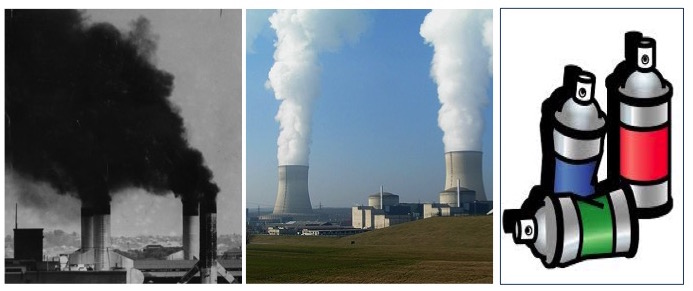Carbon, Carbon Dioxide, or Ozone ?
Black smoke, white smoke, and ozone are very different. Yet the three are commonly confused on the key issue of climate change. It is really important to keep these totally different kinds of “pollution” distinct, as only one of them greatly adds to a warming planet. Frankly, even the scientific community uses terminology that adds to the confusion. If we are going to focus on good policies and really address the critical issue of rapid warming and climate change, we need to communicate and focus on the key issue.
Black smoke is generally due to actual carbon, one of our most basic elements. It is fundamental to all organic matter (living things) and a major part of fossil fuels (hydro-carbons) which are the remains of plant matter (algae, wood, and other plants). Incomplete combustion of such material generally creates black smoke. We see that in smokestack exhaust in the picture on the left, burning vegetation, or coming out of the tailpipe of a car that is not running properly. This black carbon becomes fine particulate material in the air. It can cause breathing problems, eye irritation, and add to smog. Surprisingly, this physical carbon is not a contributor to global warming. In fact, if anything it can have a cooling effect as the physical particles in the air, reflect sunlight and heat. Particulate matter does not stay in the air very long. It settles to the ground as soot, or can be washed out by rain.
In addition to the physical carbon – the black stuff – there will almost always be carbon dioxide (CO2) and other variations like carbon monoxide mixed in that black smoke. Carbon dioxide is a completely clear gas. Perhaps recalling some school chemistry lesson, when a single carbon atom becomes bonded to two oxygen atoms, the molecule of the compound has its own properties, independent of the elements that make it. Black carbon and clear carbon dioxide are perfect examples of this chemical magic.
Unfortunately, the black carbon and the damaging clear carbon dioxide are confused further because the clear carbon dioxide produced even by complete combustion of fossil fuels is often expressed by scientists as an equivalent of pure carbon, as its “carbon footprint.”
The main point is that the black visible carbon is entirely different than the clear carbon dioxide that is the primary cause of the increased warming. The dramatic increase in carbon dioxide level is primarily due to the burning of vast quantities of fossil fuels. That is why the Earth is about one degree Celsius, or nearly two degrees Fahrenheit, warmer than it was at the start of the industrial era.
Carbon dioxide (and the other clear greenhouse gases) that trap heat in the atmosphere, like a sheet of glass in a greenhouse, may also be added to the atmosphere invisibly such as with accidental release of natural gas or it’s natural form, methane. (For more about this, see an earlier post, “Is CO2 pollution? Not really, but….“)
White smoke as shown in the middle image above of “smoke” coming out of a nuclear power plant is pure steam; just water vapor. It may add to short lived cloud formation and therefore has some temporary effect on temperature, but is not a stable “greenhouse gas” which is the primary cause of the planet getting warmer. But water vapor becomes part of the very active hydrologic cycle of evaporation, cloud formation, humidity, and rainfall, that changes every day. In contrast, carbon dioxide in the atmosphere lasts for thousands of years.
The Hole in the Ozone is the third major form of confusion about why the planet is warming. Back in the 1970’s and early 1980’s there was growing concern that another clear type of gas, the CFC’s (chloro-fluoro-carbons) used as propellants in aerosol cans and in cooling compressors was getting up high in the atmosphere and causing a rapidly growing hole in the ozone layer. That was allowing more ultraviolet radiation which was having a harmful effect on wildlife and potentially on humans. The Montreal Protocol of 1987 effectively banned CFC’s, causing industry to find alternative chemicals. (Unfortunately some of the replacements have also turned out to be harmful, but improvements continue.) As a result of that international Treaty, and the decrease in CFC’s, the hole in the ozone is repairing itself. But contrary to popular belief, the hole in the ozone has almost nothing to due with the planetary warming that is causing the oceans and atmosphere to warm, changing weather patterns, the ice to melt, and the seas to rise.
If we are going to solve problems, we need to be talking about the right issues. Understanding the difference between carbon particles, clear carbon dioxide, white smoke and ozone is essential to support good policy.
We have really big challenges ahead and must not confuse them. To identify the problems and solve them we need to clear the air.

